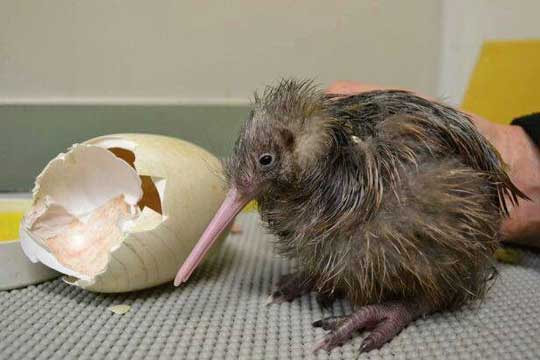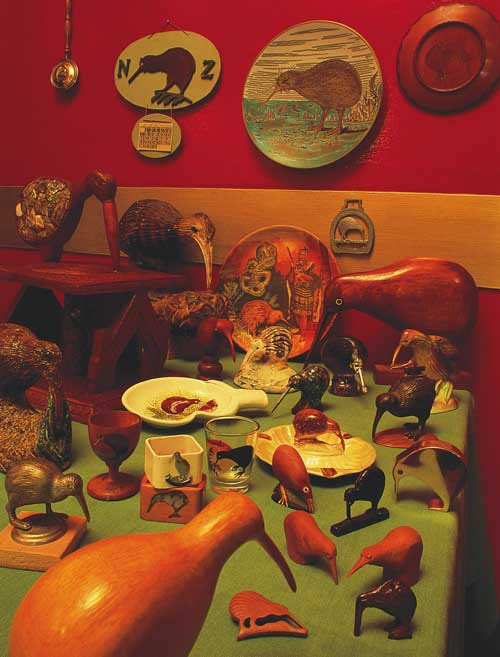|
Did you know the only mammals native to New Zealand are a few species of bats and some marine mammals (whales, dolphins, and seals)? For this reason, the Kiwi is sometimes called New Zealand's "honorary mammal." But the Kiwi, or course, is actually a bird. Wait! Did you think I was referring to those little brown, fuzzy fruits in the produce section at the market? Nope, those are actually called kiwifruit. And they definitely are not birds. Wait again! Did you think I was referring to New Zealanders? The people of New Zealand have been referred to as Kiwis since the nickname was given to them during World War I. Again, nope... I'm not talking about the people. Speaking of New Zealanders, you might think my statement above about the only native mammals being bats and sea mammals is incorrect. After all, humans are certainly mammals, so wouldn't we consider the Maori people to be mammals native to New Zealand? Well, maybe, but the Maori people discovered and settled in New Zealand only 740 years ago (close to the year 1280). That certainly makes them indigenous to the island, but 740 years isn't long compared to the 50 million years since the first kiwis appeared! What the heck is a Kiwi? Kiwis consist of five bird species living only on New Zealand. They are in the group of large, flightless birds called ratites, which includes ostriches, emus, cassowaries, rheas, and some species that are now extinct. Kiwis are the smallest (by far) of all the ratites. Perhaps their most distinguishing characteristic is that they are flightless ground birds. Amazing facts about Kiwis The genetic heritage of kiwis is confusing. They shared the island of New Zealand with an extinct type of ratites, the 500-pound (227 kg) moa. So, you would think kiwis are closely related to moas. But, DNA evidence has shown that kiwis are more closely related to the elephant birds (also extinct) from Madagascar. And regarding living species, kiwis are more closely related to the emus and cassowaries than to the moas. How can this be possible? Well, studies have shown that the ancestor of kiwis, a bird called Proapteryx, was probably capable of flight, suggesting that kiwi ancestors migrated to New Zealand separate from moas (moas were already large and flightless when the kiwi ancestor arrived on the scene). Kiwis are about the size of chickens. The largest, the great spotted kiwi, weighs about 7.3 pounds (3.3 kg), and the smallest, the little spotted kiwi, weighs 2.9 pounds (1.3 kg). I mentioned above that kiwis are sometimes referred to as "honorary mammals." Part of the reason for this is that they appear to be covered in fur, but this is actually thin, hair-like feathers. Kiwis have really strong legs. Amazingly, a kiwi's muscular legs make up about a third of its entire body weight! With these powerful legs, kiwis can run as fast as a human. In a single night, a kiwi can cover its entire territory, which is often hilly and difficult to traverse. How big is an individual's territory? Up to the size of 60 football fields. That's 79 acres (32 hectares)! Okay, this may be the most impressive thing about kiwis. These birds typically lay one egg per season, but that one egg is the largest egg (relative to their body size) of any other bird. Consider this... a human baby is typically about 5% of the weight of the mother giving birth. And (drumroll please...) the kiwi's egg can be a whopping 25% of the mother bird's weight. Let's put this into perspective. This would be like a 150-pound (68 kg) woman giving birth to a 37-pound (16.8 kg) baby. Yeeeouch! Let's look at it another way. A kiwi is about the size of a chicken, but a kiwi's egg is six times the size of a chicken's egg. If you think this might be hard on the female kiwi, you're right. During the 30 days it takes to grow the egg in her body, the female must eat three times the amount of food she normally eats. But for the last three days or so of that time, the egg gets so large that there is no room left for her to eat at all, and she must go hungry. However, there is relief for her after the egg has been laid. In four of the five kiwi species, the male is the one to incubate the egg, a process that takes 63 to 92 days (in the fifth species, both parents share the task). That's the least the male can do after all that, right? Check out the X-ray below. How are kiwis able to have such large eggs? Three reasons: First, as you can imagine, kiwis would not be able to develop such large eggs if they weren't ground birds. It would be too much weight to carry in flight. Second, kiwis typically live in areas with abundant food, allowing them to take in enough nutrients to support the development of these huge eggs. And third, until recently, when humans introduced predators to New Zealand, kiwis historically had few natural predators (which might eat the eggs or easily catch the mothers, which are slowed down by the weight). Once the egg has been laid and incubated, the kiwi baby has to kick its way out of the egg when it hatches. Unlike other birds, kiwi babies do not have an egg tooth. Since they grow so large inside the egg, and since incubation is so long, the babies hatch with a full coat of hair-like feathers. Most baby birds have that "ugly-baby-bird" look, but baby kiwis simply look like smaller versions of the adults. You know how birds that fly have hollow bones to make them lighter? Well, kiwis have marrow in their bones (like mammals), making them heavier than other birds their size. It may look like kiwis have no wings, but they actually do. The wings are only about an inch (3 cm) long and are usually hidden beneath the hair-like feathers. Each wing has a claw on the tip, but no one really knows the purpose of this claw. Kiwis' beaks are quite different from those of other birds. Their beaks are long, yet they are pliable and sensitive to touch. And kiwis are the only birds with nostrils at the end of the beak. These special beak features allow them to stick their beaks into the soil and locate worms and insects by smell without ever seeing them. Check out this video of a kiwi feeding (kiwis are nocturnal and are difficult to find in the wild, and even more difficult to photograph). One last tidbit. The kiwi is one of the most iconic symbols of any country, as iconic to New Zealand as kangaroos are to Australia. New Zealanders seem to be united in their fondness for these birds. Today, over 90 different organizations work to protect kiwis in over a half million acres (230,000 hectares) of kiwi habitat. The bird is truly a national treasure. So, the kiwi deserves a place in the A.T.A.B.C.A.H.O.F. (All That and a Bag of Chips Animal Hall of Fame). FUN FACT: The phrase "all that" was first used to mean impressive in about 1989 (such as "My girlfriend is all that!"). And then in the mid 90s, people started saying "all that and a bag of chips" to mean good, plus extra. It's possible the phrase began as a way to express your superiority, as in "You're all that, but I'm all that AND a bag of chips!." So, all that and a bag of chips is another way to say awesome! By the way, this phrase is specifically American in origin. I suppose if it had started England, it would be "All that and a bag of crisps." What would it be where you live?? Photo Credits:
Kiwi #1 - New Zealand Department of Conservation Kiwi #2 - Exploring Kiwis Kiwi X-ray - Reddit Kiwi Hatchling - Pinterest Kiwi keepsakes - New Zealand Geographic
0 Comments
Leave a Reply. |
Stan's Cogitations
Everyone needs a creative outlet. That's why I write. Archives
July 2024
|






 RSS Feed
RSS Feed